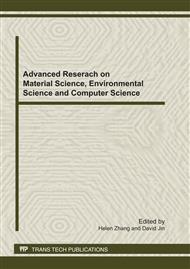p.85
p.89
p.93
p.98
p.102
p.108
p.112
p.116
p.120
Ammonium Removal from Aqueous Solutions Using an Ammonium Ion-Exchange Material, the Equilibrium Study
Abstract:
This article investigates the removal of ammonium from aqueous solutions using the ammonium ion-exchange material prepared by the modified kaolin. Batch tests were performed under a range of conditions to assess the effect of initial solution concentration, contact time and solution PH on the performance and capacity of the media for this application. The findings show that increasing initial solution concentration and contact time provide the best performance at an optimum PH of between 6 and 7 and the maximum ammonium adsorption capacity reaches at 79mgNH4+g-1 under the experimental conditions studied. Five isotherm models were used to describe the isotherm data. Three-parameter isotherm models (Redlich–Peterson and Langmuir–Freundlich) prove a better fit than two-parameter isotherm models (Langmuir, Freundlich and Temkin). These results indicate that the ammonium ion-exchange material is a promising material for cost-effective removal of ammonium from wastewater.
Info:
Periodical:
Pages:
102-107
Citation:
Online since:
August 2011
Authors:
Keywords:
Price:
Сopyright:
© 2011 Trans Tech Publications Ltd. All Rights Reserved
Share:
Citation:


